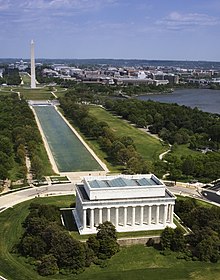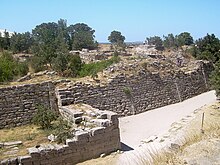Portal:Cities
The Cities Portal

A city is a human settlement of a notable size. The term "city" has different meanings around the world and in some places the settlement can be very small. Even where the term is limited to larger settlements, there is no universally agreed definition of the lower boundary for their size. In a more narrow sense, a city can be defined as a permanent and densely settled place with administratively defined boundaries whose members work primarily on non-agricultural tasks. Cities generally have extensive systems for housing, transportation, sanitation, utilities, land use, production of goods, and communication. Their density facilitates interaction between people, government organizations, and businesses, sometimes benefiting different parties in the process, such as improving the efficiency of goods and service distribution.
Historically, city dwellers have been a small proportion of humanity overall, but following two centuries of unprecedented and rapid urbanization, more than half of the world population now lives in cities, which has had profound consequences for global sustainability. Present-day cities usually form the core of larger metropolitan areas and urban areas—creating numerous commuters traveling toward city centres for employment, entertainment, and education. However, in a world of intensifying globalization, all cities are to varying degrees also connected globally beyond these regions. This increased influence means that cities also have significant influences on global issues, such as sustainable development, climate change, and global health. Because of these major influences on global issues, the international community has prioritized investment in sustainable cities through Sustainable Development Goal 11. Due to the efficiency of transportation and the smaller land consumption, dense cities hold the potential to have a smaller ecological footprint per inhabitant than more sparsely populated areas. Therefore, compact cities are often referred to as a crucial element in fighting climate change. However, this concentration can also have significant negative consequences, such as forming urban heat islands, concentrating pollution, and stressing water supplies and other resources. (Full article...)
Selected city -
Troy (Turkish: Troya, Greek: Τροία, Hittite: 𒋫𒊒𒄿𒊭 Truwiša/Taruiša) or Ilion (Greek: Ίλιον, Hittite: 𒌷𒃾𒇻𒊭 Wiluša) was an ancient country located in present-day Hisarlık, Turkey. The place was first settled around 3600 BC and grew into a small fortified city around 3000 BC. During its four thousand years of existence, Troy was repeatedly destroyed and rebuilt. As a result, the archeological site that has been left is divided into nine layers, each corresponding to a city built on the ruins of the previous. Archaeologists refer to these layers using Roman numerals. Among the early layers, Troy II is notable for its wealth and imposing architecture. During the Late Bronze Age, Troy was called Wilusa and was a vassal of the Hittite Empire. The final layers (Troy VIII-IX) were Greek and Roman cities which in their days served as tourist attractions and religious centers because of their link to mythic tradition.
The archaeological site is open to the public as a tourist destination, and was added to the UNESCO World Heritage list in 1998. The site was excavated by Heinrich Schliemann and Frank Calvert starting in 1871. Under the ruins of the classical city, they found the remains of numerous earlier settlements. Several of these layers resemble literary depictions of Troy, leading some scholars to conclude that there is a kernel of truth underlying the legends. Subsequent excavations by others have added to the modern understanding of the site, though the exact relationship between myth and reality remains unclear and there is no definitive evidence for a Greek attack on the city. (Full article...)Did you know -
- ... that the African Union has set up a space agency in a Space City?
- ... that in the 2000s, New York City's Benjamin Hotel offered a pillow menu and hired a sleep concierge?
- ... that Miao Poya successfully campaigned to change her high school's uniform policy before becoming one of the first Taipei city councillors to be openly lesbian?
- ... that there are few tall buildings on Long Island because residents do not want it to become "Queensified", referring to the neighboring New York City borough?
- ... that City Pier A's clock tower was the first memorial to World War I casualties in the United States, according to a New York City government spokesperson?
- ... that one of Beverly Robertson's biggest accomplishments as CEO of the Greater Memphis Chamber was attracting the Ford Motor Company's US$5.6 billion Blue Oval City complex to Memphis, Tennessee?
Related portals
Related WikiProjects

Washington, D.C., formally the District of Columbia and commonly called Washington or D.C., is the capital city and federal district of the United States. The city is on the Potomac River, across from Virginia, and shares land borders with Maryland to its north and east. Washington, D.C., was named for George Washington, a Founding Father and the first president of the United States. The district is named for Columbia, the female personification of the nation.
Washington, D.C., anchors the southern end of the Northeast megalopolis, one of the nation's largest and most influential cultural, political, and economic regions. As the seat of the U.S. federal government and several international organizations, the city is an important world political capital. The city had 20.7 million domestic visitors and 1.2 million international visitors, ranking seventh among U.S. cities as of 2022. (Full article...)Selected article -
In United States local government, a consolidated city-county (also known as either a city-parish or a consolidated government in Louisiana, depending on the locality, or a unified municipality, unified home rule borough, or city and borough in Alaska) is formed when one or more cities and their surrounding county (parish in Louisiana, borough in Alaska) merge into one unified jurisdiction. As such it is a type of unitary authority that has the governmental powers of both a municipal corporation and a county.
A consolidated city-county is different from an independent city, although the latter may result from consolidation of a city and a county and may also have the same powers as a consolidated city-county. An independent city is a city not deemed by its state to be located within the boundary of any county and considered a primary administrative division of its state. A consolidated city-county differs from an independent city in that the city and county both nominally exist, although they have a consolidated government, whereas in an independent city, the county does not even nominally exist. Furthermore, a consolidated city-county may still contain independent municipalities maintaining some governmental powers that did not merge with the rest of the county. (Full article...)General images -
Topics
List articles
Subcategories
Associated Wikimedia
The following Wikimedia Foundation sister projects provide more on this subject:
-
Commons
Free media repository -
Wikibooks
Free textbooks and manuals -
Wikidata
Free knowledge base -
Wikinews
Free-content news -
Wikiquote
Collection of quotations -
Wikisource
Free-content library -
Wikiversity
Free learning tools -
Wiktionary
Dictionary and thesaurus








































